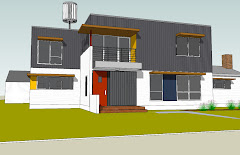 Solar Power is a must for this project - we'd rather be energy producers than energy buyers, and producing our own power (or at least a good portion of it) removes us from the volatility of the energy market and reduces our dependence on coal produced electricity and natural gas. A solar heating system is a great investment because your property value increases when you become your own power producer.
Solar Power is a must for this project - we'd rather be energy producers than energy buyers, and producing our own power (or at least a good portion of it) removes us from the volatility of the energy market and reduces our dependence on coal produced electricity and natural gas. A solar heating system is a great investment because your property value increases when you become your own power producer.First - let's dispel the notion that solar power doesn't make sense in Minnesota. We see as many solar days as much of the south - Texas, Florida, California. One of the advantages of living in a cold climate is that we often have very clear skies during the winter months.
We're working with Mario of Best Power International to design our systems - we selected Mario over other renewable energy specialists for a few reasons - 1. He returned our phone calls, 2. He's a neighbor and 3. He's very knowledgeable and professional. We like him.
We've decided to use a hybrid system - both solar hot water and solar electric (PV). Our water heating needs for our home will be taken care of by 2 flat plate collectors angled at about 45 degrees facing true south. These will be mounted on our roof top along with a 2 rows of solar PV modules which will produce upwards of 50% of our electrical needs (more if we can get our kids to turn the lights off) annually, on average. The system is designed to be expandable, and hopefully we'll be able to add more modules as our finances allow in the future. The PV modules will be tied back to the utility grid, so that on very sunny days and times when our system is producing more power than we are using - we will be selling that power back to the utility provider. At night, or at high energy demands - we'll be taking power back off the grid. We opted not to do battery storage in favor of the grid tied system for a few reasons - of which I'll tell when I'm good and ready. We do have a small inverter and battery sub-panel for those times when the power goes out and we want our sump pump and refrigerator to stay running.
We plan to do energy monitoring to track the systems performances over time.
The solar hot water and PV systems are eligible for State rebates and Federal Tax credits - which helps bring our costs down by about 25% and helps decrease the payback period on the systems.
We are also looking at connecting a small, vertical axis wind turbine to this system (http://www.pacwind.net/) These turbines are very efficient at low wind speeds and will produce power any time the wind is blowing - at night and on cloudy days! We expect that the turbine could produce the balance of our electrical needs. Net zero energy here we come! We're still working out the design integration of the system, so we'll report back with news when we have it.


No comments:
Post a Comment